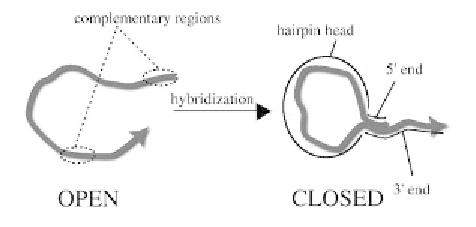Biomedical Engineering Reference
In-Depth Information
Figure 7. Nucleic acid hairpin
EXAMPLE OF A NUCLEIC ACID
NANODEvICE
freed. Now
B'
is toehold is exposed. Strand
B'
recognizes the toehold, binds to it and
displaces
C
. As a result,
B'
totally hybrid-
izes to
B
and frees the output strand
C
.
Apart from logical gates, DNA's and RNA's
competitive hybridization property can also be
used to design nanodevices like molecular motors
(Yurke, 2000; Shin, 2004) and biosensors (Beyer,
2006; Stojanovic, 2004).
In the following, we explain a simple nanode-
vice that operates like a molecular motor. It
consists of a hairpin fuelled by two strands of
nucleic acids with open and closed states. The
importance of this nanodevice is that it can be
controlled by means of genetic regulation and
work like a biosensor.
Figure 7 is a strand of nucleic acids with two
complementary regions, situated at the 5' end and
3' end. In energy terms, the hybridization between
the two regions is favourable. This produces a
hairpin-shaped strand. This structure is very use-
ful for computation with nucleic acids (Benenson,
2004; Beyer, 2006; Sakamoto, 2000).
In the following we explain how this DNA
nanodevice works. The hairpin switches from
closed to open when the gene
F
is activated and
transcribes a fuel-strand
F
, as shown in Figure 8.
The strand
F
recognizes and binds to the hairpin
toehold
H
.
F
has a greater affinity to the 3' end
and displaces and releases the 5' end. This opens
the hairpin.
•
If
A'
is not present,
B'
is toehold is never
exposed because
A
hybridizes with
B
and
therefore does not free
C
.
•
If strand
B'
is not present,
A'
hybridizes
with
A
but does not free strand
C
because
it hybridizes with
B
.
•
Finally, if neither
A'
nor
B'
are present,
C
is
not freed because it hybridizes to
B
.
This explanation of how the AND gate works
is for individual molecules. Remember though that
it is the molecule concentrations that are equiva-
lent to the logical '1' and '0'. If the concentration
of
A
is high, INPUT 1= '1', we will have a high
concentration of gates with exposed toeholds of
B
.
If the concentration of
B
is also high, INPUT 2=
'1', we will have a high concentration of free
C
,
OUTPUT= '1'. On the other hand, if either or both
of the input concentrations are low, the concentra-
tion of free
C
will be low, OUTPUT= '0'.
Unlike circuits based on genetic regulation,
competitive hybridization-driven circuits are more
prone to modularity and scalability because the
only biomolecules involved are nucleic acids, i.e.
the input and output signals are of the same type
(Seelig, 2006).

Search WWH ::

Custom Search